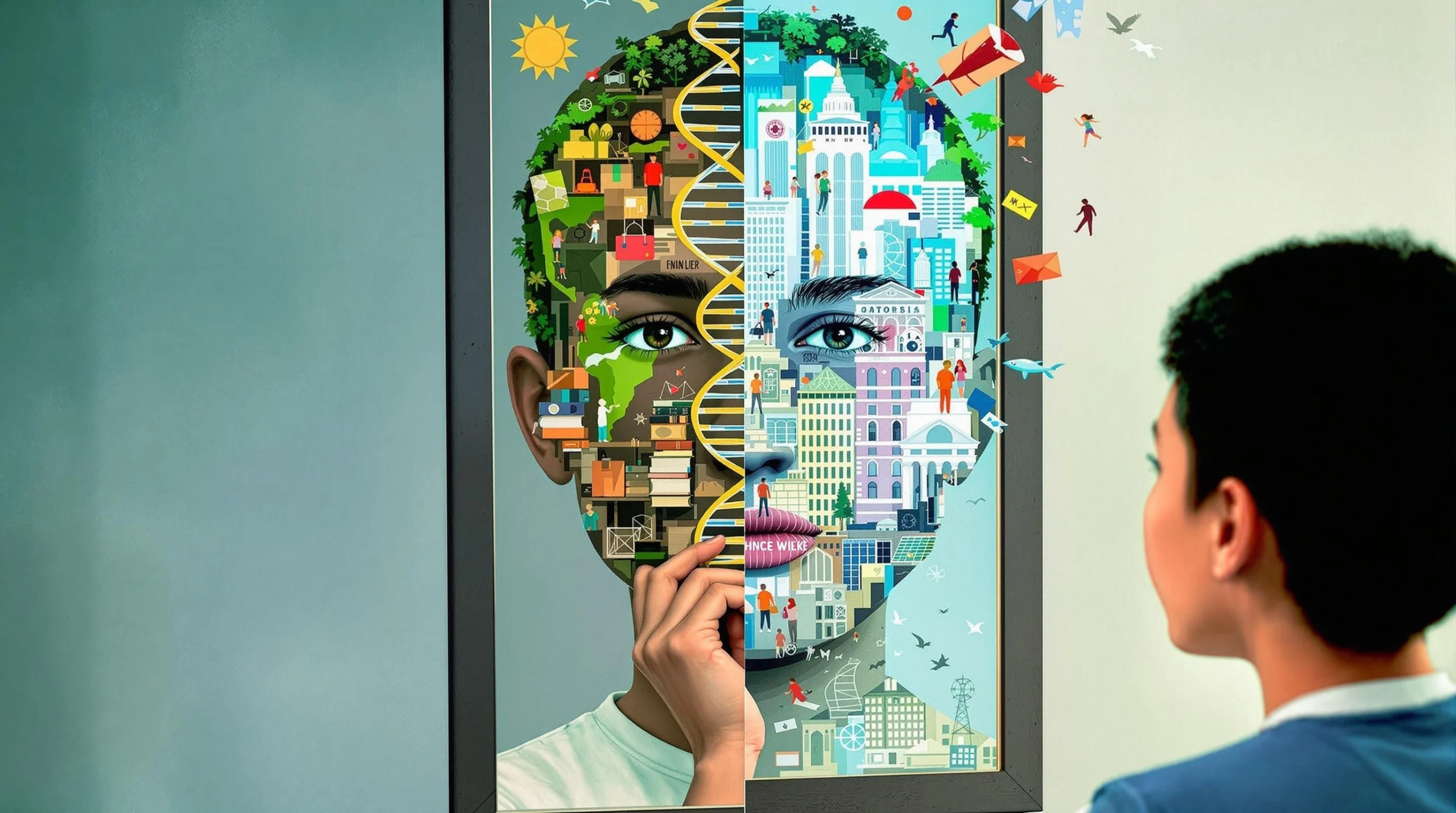The age-old question of “nature versus nurture” has fascinated scientists, philosophers, and curious minds for centuries. As we advance in our understanding of genetics and human development, we’re beginning to unravel which aspects of who we are come from our DNA and which are shaped by our experiences. Understanding this distinction isn’t just academic curiosity—it has profound implications for how we view ourselves, raise our children, and approach health and wellness.
Your genes hold the basic instructions for your body to grow and function, but they’re far from the only thing controlling your traits. Most characteristics are shaped by both genetic and environmental factors working together—not nature versus nurture, but nature with nurture.
Understanding Heritability: The Genetic Foundation
To understand which traits are primarily genetic, it’s essential to grasp the concept of heritability. This refers to the proportion of variation in a particular characteristic that can be attributed to genetic factors, rather than environmental influences. Research indicates that approximately 60-80% of an individual’s height is influenced by their genetic makeup, with the remaining percentage affected by factors such as nutrition and overall health.
A trait that is completely determined by genetics would have 100% heritability; one completely determined by environment would have zero heritability. However, very few human traits fall at these extremes—most exist somewhere in between.
Physical Traits: The Most Visible Genetic Influences
Some of our most noticeable characteristics show strong genetic determination:
- Eye color is largely determined by variations in multiple genes. Scientists have identified at least eight genes influencing eye color, with the OCA2 gene on chromosome 15 playing a major role in controlling the brown/blue spectrum. The genes control melanin production in the iris—more melanin results in brown eyes, less creates blue eyes. Contrary to what many of us learned in school, eye color inheritance is much more complex than a simple dominant/recessive pattern.
- Height represents a classic example of polygenic inheritance—traits controlled by multiple genes. Scientists have discovered more than 700 gene variants related to height, with estimates suggesting about 80% of height variation is attributable to genetics. The remaining 20% comes from environmental factors like nutrition.
- Hair texture (straight, wavy, or curly) is strongly influenced by genes that determine the shape of hair follicles. Round follicles produce straight hair, oval follicles create wavy hair, and flattened or c-shaped follicles result in curly hair. While curly hair runs in families, its inheritance patterns can be unpredictable since multiple genes are involved.
Temperament and Personality: The Genetic Blueprint of Behavior
Our basic behavioral tendencies also show significant genetic influence. Temperament includes traits such as:
- Tendency toward extroversion or introversion
- Emotional reactivity (calm or easily upset)
- Energy disposition (energetic or relaxed)
- Concentration capacity (attentive or distractible)
- Resolve (steadfast or quick to give up)
Research consistently demonstrates that genetics accounts for approximately 20-60% of temperament variation. Twin studies provide compelling evidence—identical twins (who share complete genetic material) commonly display remarkably similar behavioral tendencies compared to non-identical siblings (sharing about 50% of DNA). Research shows that even identical twins who grew up in different family environments still demonstrate striking similarities in personality traits.
The widely accepted Big Five personality model—openness, conscientiousness, extraversion, agreeableness, and neuroticism—shows heritability estimates of around 40-60%. Recent genome-wide association studies have identified more than 700 genes that influence temperament by affecting processes related to synaptic plasticity and long-term learning and memory.
Researchers have discovered connections between specific genetic variations and certain personality characteristics. For instance, certain variations in the PCDH15 and WSCD2 genetic structures have been correlated with social behavior patterns, while particular variations of the MAOA gene appear to correlate with introverted tendencies. Additional genetic markers including SLC6A4, AGBL2, and BAIAP2 have been associated with predispositions toward anxiety and depressive traits.
Intelligence: Complex Genetic and Environmental Interplay
Intelligence represents one of the most studied yet complex examples of genetic influence. Like most aspects of human behavior and cognition, intelligence is influenced by both genetic and environmental factors. It includes abilities such as reasoning, planning, problem-solving, abstract thinking, and understanding complex ideas.
Studies show that intelligence has a significant genetic component, though researchers haven’t conclusively identified specific genes with major roles. It likely involves many genes, each making small contributions. Meanwhile, environmental factors like home environment, parenting, education, learning resources, healthcare, and nutrition strongly influence cognitive development.
Teasing apart genetic and environmental effects can be challenging. If a child’s intelligence resembles their parents’, is that similarity due to inherited genes, shared environment, or a combination? Most research suggests it’s both, with complex interactions between genes and environment.
The Environment’s Role: More Than Just External Factors
Environmental influences are more complex than we once thought. They include not just obvious external factors but also how these factors interact with our genetic makeup. Sometimes environmental conditions can actually change gene expression—turning genes on or off without altering the DNA sequence itself.
For example, children raised in adverse conditions (neglect, abuse, or poverty) often develop more impulsive temperaments because this environment “activates” impulsivity-related genes that might otherwise remain dormant. Those raised in nurturing, safe environments are more likely to have calmer temperaments because different genes are activated.
As one researcher notes: “It’s oversimplistic to claim that genetics accounts for a certain percentage of a characteristic while environment accounts for the remainder, particularly because societal influences may have homogenized environmental conditions, creating similar circumstances for many individuals within a community.”
Skills and Preferences: Where Environment Often Dominates
Many complex human behaviors, skills, and preferences show lower heritability than physical traits or basic temperament. Language acquisition, specific academic skills, cultural practices, and social behaviors are examples where environmental factors typically play a larger role than genetics—though genetic factors still contribute to individual differences in aptitude and ease of learning.
The “Missing Heritability” Problem
Despite advances in genetic research, scientists still face a “missing heritability” problem—current genetic studies don’t fully account for the heritability estimated from twin and family studies. There are several reasons why genome-wide association studies might under-detect DNA variations that contribute to heritability, suggesting that future, more powerful studies will help close this gap.
Practical Implications: Working With, Not Against, Your Genetic Blueprint
Understanding which traits are primarily genetic can help us set realistic expectations and develop more effective strategies for personal growth and family development:
- Health approaches: While we can’t control genetic risk factors for conditions like heart disease, nor environmental factors like age and gender, our behaviors play a large part. Diet, physical activity, and lifestyle choices significantly shape our health outcomes despite genetic predispositions.
- Parenting strategies: Rather than trying to change fundamental aspects of a child’s temperament, parents can work with these genetic predispositions to help children develop their strengths and manage their challenges.
- Personal development: Recognizing which aspects of ourselves are more genetically influenced can help us focus our energy on areas where change is more feasible, while accepting and embracing our inherent tendencies.
Beyond Genetic Determinism
It’s crucial to avoid genetic determinism—the belief that genes entirely control human traits and destiny. Current research suggests that personality traits come from a combination of genetic (30-60%) and environmental factors. The old “nature versus nurture” debate is overly simplistic. Instead, we should appreciate the intricate dance between our genetic blueprint and our environmental experiences in shaping who we are.
Apart from a few traits like blood type, virtually all characteristics that vary between humans are complex traits influenced by many genes and environmental factors. Even characteristics commonly thought to be determined by a single gene—like eye color, tongue rolling, and chin clefts—are actually influenced by multiple genetic and environmental factors.
While we may be born with certain genetic predispositions, we still have remarkable capacity to develop and change throughout life. By understanding which traits are primarily genetic, we can better appreciate our inherent strengths and challenges, make more informed decisions about our health and development, and ultimately work with—rather than against—our genetic predispositions to lead fulfilling, authentic lives.
This knowledge empowers us to focus our energy on aspects of ourselves we can influence while accepting and embracing the unique genetic gifts that make us who we are. The fascinating interplay between nature and nurture continues to reveal that we are neither solely the product of our genes nor entirely shaped by our experiences—but rather the beautiful result of both forces working together throughout our lives.

